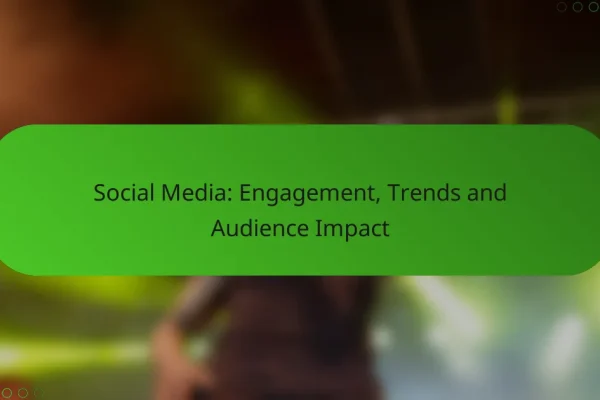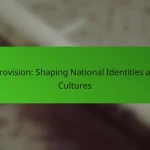What are the latest trends in the Eurovision Song Contest?
The latest trends in the Eurovision Song Contest highlight a shift towards greater digital interaction, diverse musical styles, and innovative voting methods. These changes reflect the evolving preferences of audiences and the impact of technology on the competition.
Increased focus on social media engagement
Social media engagement has become a crucial aspect of the Eurovision Song Contest, with contestants actively using platforms like Instagram, TikTok, and Twitter to connect with fans. This trend allows artists to build their brand and generate buzz before and during the event.
Fans now participate in discussions, share performances, and vote for their favorites online, creating a more interactive experience. Contestants who effectively leverage social media often see increased support and visibility, making it essential for participants to develop a strong online presence.
Diversity in musical genres
The Eurovision Song Contest has embraced a wider range of musical genres, moving beyond traditional pop to include styles like rock, hip-hop, and folk. This diversity allows for a richer competition and appeals to a broader audience, reflecting global musical trends.
Countries are increasingly showcasing their cultural heritage through music, resulting in unique performances that resonate with both local and international viewers. This trend encourages artists to experiment with their sound, leading to memorable and innovative entries.
Emergence of digital voting systems
Digital voting systems have transformed how viewers participate in the Eurovision Song Contest, making it easier and more accessible for fans to cast their votes. Many countries now utilize apps and online platforms that allow for real-time voting, enhancing audience engagement.
These systems often include features like instant feedback and interactive elements, encouraging viewers to stay involved throughout the event. However, it’s crucial for organizers to ensure the security and fairness of these digital voting methods to maintain the integrity of the competition.
How has the Eurovision Song Contest evolved over the years?
The Eurovision Song Contest has transformed significantly since its inception in the mid-1950s, adapting to changing musical trends, technology, and cultural dynamics. Key developments include shifts in performance styles, alterations in voting mechanisms, and an increasing emphasis on cultural representation.
Shift from traditional to modern performances
Over the decades, Eurovision performances have transitioned from simple, traditional showcases to elaborate productions featuring advanced technology and diverse artistic expressions. Early entries often focused on vocal talent and straightforward staging, while recent years have embraced multimedia elements, choreography, and innovative stage designs.
This shift reflects broader trends in the music industry, where visual appeal and audience engagement play crucial roles. For instance, many recent acts incorporate dance routines, elaborate costumes, and interactive elements that enhance viewer experience.
Changes in voting systems
The voting system of the Eurovision Song Contest has undergone significant changes, particularly in how points are awarded. Originally, countries voted solely through a jury system, but this evolved to include public voting, which has become a major influence on the outcome.
Currently, each participating country combines jury votes and public votes to determine the final scores, creating a more democratic and engaging process. This dual system has led to a more unpredictable competition, where fan favorites can emerge unexpectedly.
Impact of cultural representation
Cultural representation has become a focal point in the Eurovision Song Contest, with countries increasingly showcasing their unique identities through music and performance. This trend highlights the diversity of European cultures and promotes inclusivity within the competition.
Artists now often incorporate traditional elements from their home countries, blending them with contemporary styles to create a unique sound. This not only enriches the contest but also fosters a greater appreciation for cultural diversity among audiences across Europe.
What are the top countries dominating Eurovision trends?
Sweden, Italy, and Ukraine are currently the leading countries shaping Eurovision trends. Each of these nations has distinct characteristics that contribute to their success and influence in the contest.
Sweden’s consistent success
Sweden has a long-standing reputation for excellence in the Eurovision Song Contest, frequently finishing in the top ranks. The country’s success can be attributed to its strong music industry, which produces high-quality pop songs and skilled performers.
Notably, Sweden has won the contest multiple times, with a notable victory in 2015 by Måns Zelmerlöw. The Melodifestivalen, Sweden’s national selection competition, plays a crucial role in identifying and promoting talent, ensuring a steady stream of competitive entries.
Italy’s resurgence in popularity
Italy has experienced a significant revival in Eurovision popularity over the past decade, marked by its return to the contest in 2011 after a long hiatus. The country’s entries often blend traditional Italian music with contemporary styles, appealing to a broad audience.
Recent performances, such as Måneskin’s win in 2021, have showcased Italy’s ability to captivate viewers with unique and energetic acts. This resurgence highlights a growing trend of embracing diverse musical influences, which resonates well with the Eurovision audience.
Ukraine’s unique cultural influence
Ukraine stands out in Eurovision for its rich cultural heritage and the incorporation of traditional elements into modern performances. The country has gained recognition for its powerful storytelling and emotional depth, often reflecting its historical and social context.
Ukraine’s success, including its 2016 win with Jamala’s “1944,” emphasizes the importance of cultural narratives in connecting with the audience. This approach not only entertains but also raises awareness of significant issues, making Ukraine a compelling participant in the contest.
How do Eurovision trends influence music industry standards?
Eurovision trends significantly shape music industry standards by introducing innovative styles and diverse cultural influences. These trends often dictate what genres become popular and how artists approach production, branding, and collaboration.
Inspiration for pop music production
Eurovision serves as a platform for unique musical styles that inspire pop music production worldwide. Artists often draw from the eclectic mix of genres showcased, incorporating elements like catchy hooks, vibrant instrumentation, and theatrical performances into their work.
For example, the use of electronic beats and multicultural sounds has become more prevalent in mainstream pop, reflecting the diverse entries seen at Eurovision. Producers are encouraged to experiment with these influences to create fresh and engaging music that resonates with a global audience.
Impact on artist branding strategies
Eurovision influences how artists brand themselves, pushing them to adopt distinctive and memorable identities. The competition highlights the importance of visual storytelling, leading artists to invest in elaborate staging, costumes, and promotional materials that align with their musical themes.
Additionally, artists often leverage their Eurovision participation to enhance their visibility and credibility, using the platform to reach wider audiences. This can lead to increased streaming numbers and opportunities for international tours.
Collaboration between countries and artists
Eurovision fosters collaboration between artists from different countries, encouraging cross-cultural partnerships that can lead to innovative music. Many artists collaborate on entries, blending their unique styles to create songs that appeal to a broader audience.
This trend has resulted in successful duets and collaborations in the mainstream music scene, where artists from various backgrounds come together to produce chart-topping hits. Such partnerships not only enhance creativity but also promote cultural exchange and understanding within the music industry.
What are the key factors driving Eurovision viewership?
The key factors driving Eurovision viewership include innovative staging and visuals, celebrity involvement, and engagement through interactive platforms. These elements not only enhance the entertainment value but also foster a deeper connection with the audience, leading to increased viewership numbers.
Innovative staging and visuals
Innovative staging and visuals play a crucial role in attracting viewers to the Eurovision Song Contest. Spectacular light shows, elaborate set designs, and creative choreography can transform a performance into a memorable experience. Countries often invest significantly in these aspects, with budgets ranging from tens of thousands to millions of euros.
For example, the use of augmented reality and high-definition screens has become common, allowing for immersive performances that captivate audiences both in-person and at home. This focus on visual appeal is essential in a competition where first impressions can influence voting outcomes.
Celebrity involvement and endorsements
Celebrity involvement and endorsements significantly boost Eurovision’s visibility and appeal. When well-known artists participate or endorse a contestant, it can attract their fan base, increasing overall viewership. This trend has led to collaborations between established stars and emerging talents, enhancing the show’s profile.
For instance, past contestants who have gained international fame often return as guest performers, drawing in their followers and creating buzz around the event. This strategy not only elevates the competition but also provides a platform for lesser-known artists to gain exposure.
Engagement through interactive platforms
Engagement through interactive platforms is increasingly vital for driving Eurovision viewership. Social media and mobile apps allow fans to participate in real-time voting and discussions, creating a sense of community and involvement. This interaction can significantly enhance viewer loyalty and excitement leading up to and during the event.
Platforms like Twitter and Instagram are often used for live updates, behind-the-scenes content, and fan polls, making the audience feel more connected to the performances. Additionally, the introduction of features like live voting through mobile apps has made participation easier and more immediate, further increasing engagement levels.
How do cultural elements shape Eurovision performances?
Cultural elements significantly influence Eurovision performances by reflecting the unique identity of each participating country. These elements enhance the visual and auditory experience, making performances memorable and resonant with audiences.
Integration of traditional instruments
Many Eurovision entries incorporate traditional instruments to highlight their cultural heritage. For example, countries like Greece often feature the bouzouki, while Ireland may include the fiddle. This integration not only enriches the musical texture but also connects the performance to the country’s history and traditions.
Using traditional instruments can create a distinctive sound that sets a performance apart. Contestants should consider how these instruments can complement modern elements, ensuring a balance between tradition and contemporary appeal.
Use of native languages in songs
Performing in a native language can enhance the authenticity of a Eurovision entry. Many artists choose to sing in their country’s official language, which can evoke a sense of pride and cultural connection. For instance, songs in Italian or Spanish often resonate deeply with audiences familiar with those languages.
However, artists should be mindful of their target audience. While native languages can create a strong emotional impact, including a few phrases in English or providing subtitles can help broaden accessibility and understanding.
Showcasing national costumes
National costumes play a crucial role in visually representing a country’s culture during Eurovision. These outfits often feature traditional designs, colors, and materials that reflect the nation’s identity. For example, the elaborate folk costumes from Eastern European countries can captivate viewers and enhance the overall performance.
When selecting costumes, performers should ensure that their attire aligns with the song’s theme and message. A well-chosen costume can elevate a performance, making it more engaging and memorable while celebrating cultural diversity.







